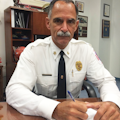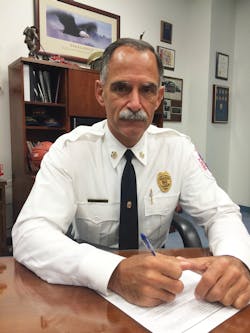Chief Concerns: Who Are You Listening To?
There are many keys to success. The art of listening is the key we’ll talk about here.
We seem to have lost the keys to listening somewhere along the way—both figurative and literal listening. Who are you “listening” to? You have heard me say these two self-truths before: 1) I don’t know it all and 2) neither does anyone else. If we are to succeed and survive, we NEED to depend on and learn from each other. We need to be each other’s keys to success and listen to each other.
Staying focused
Are you reading Firehouse Magazine on a regular basis? Are you listening to podcasts? Are you watching training videos? Are you putting feet on the street to drill and train? Are you using your personal 360 (firehouse.com/12352564) to make sure your personal and professional performance is maximized?
We should approach life as a learning journey, allowing in as much relevant information as is manageable. Each trip on the journey has keys that will open different paths and ideas. Determining the relevance of all those paths and ideas is where we usually falter, allowing all those negative pressures to interrupt our focus.
There are so many topics out there, so I completely understand how difficult it can be to focus on any one of them. How many times have you walked into a room and forgotten WHY you came in that room? Or you only got something half done because something or someone else distracted you? If that hasn’t happened to you, it will, sooner or later—stand by.
But hey, when that alarm sounds, you know EXACTLY where to go and what to do—no questions, no problems. Adrenaline is one of the keys that kicks in and allows your brain to instantly focus and succeed. But don’t get over-confident, as this instant focus is relatively momentary. There are a lot of steps to ensure that you get there and you’re fully ready when you arrive. Like muscle memory, clicking those snaps and pulling that hood up are repetitive steps you’ve practiced over and over until you can do them in your sleep. Or have you practiced it over and over?
The multi-tasking trick for me is steeped in my self-diagnosed attention deficit disorder (ADD). Managing the multi-tasking is a full-time job in and of itself; however, managing it is exactly how I’ve been able to succeed where others may have failed. Developing a daily personal road map (sort of a mini-strategic plan) is the key that has helped me listen and manage routine tasks, while ensuring that I get back to those tasks when I’ve been distracted by something else.
For those routine things in your day, make a list (for me, it’s a daily note on my iPhone). Sit down first thing in the morning and plan out your day. I PROMISE you that if you take just 5 minutes to capture just enough simple bulleted words to remind you that something needs to happen, you will see a difference. Now granted, you have to remember to LOOK at the list, but the list itself is a start.
When you’ve completed a task, line it out or delete it; this is part of the decluttering process. If you leave everything on your list all the time, it will become discouraging and distracting and, ultimately, little if anything substantive will get done. Those small steps of accomplishment will go a long way toward ensuring you’re successful.
Now that you’ve captured everything for the day on your list, the key to completing everything is making sure there is order to the list, whether that’s chronologic, geographic or something else. It won’t do you any good to have a list that you’re simply following from top to bottom if the stuff in the middle is all over the place, making it physically impossible to achieve.
Making the list is partially about listening to yourself. Most firefighters and paramedics are Type A personalities and can likely relate to feeling like they “know it all,” and feeling like they can manage it all in their head. From time to time, you do and you can; however, I’m just suggesting that putting it on an actual list is the key to not forgetting it. Are you listening to yourself?
Listening to others
One of the more difficult things for me to overcome in my own ADD world was the possibility that firefighting tactics could change over time. It wasn’t too many years ago that my slide-rule friends Dan Madrzykowski and Steve Kerber were the keys to convincing us that flow path research had disproved nearly EVERYTHING I held near and dear to my aggressive tactical training and personal firefighting theories. Over those 36 years, I allowed the “fire triangle” to become the “fire tetrahedron” in MY mind because I didn’t really think it impacted me, and I allowed advances in gear protection garments to exist in MY mind because I didn’t have a choice, but heaven forbid was I going to allow science to endanger me and everyone I’m sworn to protect. Well, I was wrong, but it took nearly losing two firefighters in a basement fire to finally open my eyes and my mind to the possibility that the science might be right.
That incident at 57th Avenue was the key that opened my eyes and a lot of others’ eyes, similar to how every other near-miss report should open eyes and minds (I hope). The 57th Avenue Safety Investigation Team (SIT) report can be accessed at http://tinyurl.com/PGFD-57.
It took listening to the scientist I unknowingly so despised to unlock my mind to a new reality. We need to listen to everyone in our realm—all levels of firefighters, EMTs, paramedics, dispatchers, paid, volunteer.
Filtering relevance and minimizing mission creep is always the challenge of listening to “everyone,” but I’m telling you that you’ll learn more and be better for it. At the other end of the scientific spectrum, yet similarly, take time to listen to the new guy or gal on the street. They have hopefully spent the last year or so absorbing anything and everything new and old about firefighting and emergency response. If you really listen to them, you’ll know soon enough whether THEY have been listening to the right people/information. It is usually the new person who notices the little intricacies that many of our more experienced folks might miss. We miss those “little” things out of complacency, tunnel-vision, know-it-all complex, and (let’s face it) age. While some will remain as sharp as a tack for as long as they’re on the job, the majority won’t.
Another key to staying sharp is indeed found with the newer folks. They help us remember that we need to put feet on the street to drill and exercise, as much if not more than we need to read the books and watch the videos. YES, we need the newer folks to help US keep sharp and be continuous learners. Remember, you DON’T know it all!
How about your community: Are you listening to them? We should be attending all kinds of community events: YMCAs, Scouts, faith-based events, political town halls, HOA meetings, community picnics, holiday festivals, etc. Keeping your community’s trust and goodwill is a primary key to maintaining mission focus. Listening in your community is where you learn more about your strengths and weaknesses than you’ll ever learn by sitting on the couch. Smoke alarms, residential sprinklers, fund raising, recruitment, fire prevention, health and well-being, CPR/AED training, among an infinite number of other things should be part of your repertoire while out in the community. But don’t just talk—LISTEN. Maybe there’s something you SHOULD be doing in your community that they’re trying to tell you isn’t being done, or maybe there’s a better way to reach others in your community. You’ll never know if you don’t listen. Being a good listener is one of the main keys to a respected and effective community partner.
Take a moment to listen
We can learn from anybody. Admittedly, we may learn what NOT to do from watching many paths we cross. The simple key is to truly just listen to what people have to say. Listen and consider for at least a moment that something they have to say might be right or might be wrong. You’ll never know if you don’t take a second to listen.
About the Author

Marc S. Bashoor
MARC S. BASHOOR joined the fire service in 1981. In 2017, he retired as fire chief of Prince George’s County, MD, Fire/EMS, the largest combination department in North America. His progressive community-based approach led to record hiring and a strategic apparatus replacement plan.
Twitter: @ChiefBashoor
Email: [email protected]
